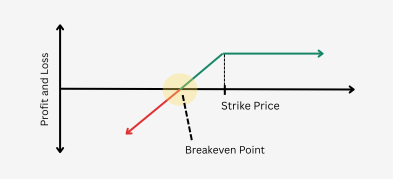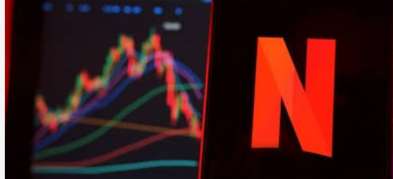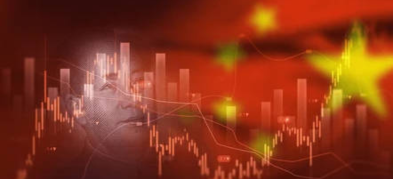
Ultima Markets App
Trade Anytime, Anywhere
Important Information
This website is managed by Ultima Markets’ international entities, and it’s important to emphasise that they are not subject to regulation by the FCA in the UK. Therefore, you must understand that you will not have the FCA’s protection when investing through this website – for example:
- You will not be guaranteed Negative Balance Protection
- You will not be protected by FCA’s leverage restrictions
- You will not have the right to settle disputes via the Financial Ombudsman Service (FOS)
- You will not be protected by Financial Services Compensation Scheme (FSCS)
- Any monies deposited will not be afforded the protection required under the FCA Client Assets Sourcebook. The level of protection for your funds will be determined by the regulations of the relevant local regulator.
Note: Ultima Markets is currently developing a dedicated website for UK clients and expects to onboard UK clients under FCA regulations in 2026.
If you would like to proceed and visit this website, you acknowledge and confirm the following:
- 1.The website is owned by Ultima Markets’ international entities and not by Ultima Markets UK Ltd, which is regulated by the FCA.
- 2.Ultima Markets Limited, or any of the Ultima Markets international entities, are neither based in the UK nor licensed by the FCA.
- 3.You are accessing the website at your own initiative and have not been solicited by Ultima Markets Limited in any way.
- 4.Investing through this website does not grant you the protections provided by the FCA.
- 5.Should you choose to invest through this website or with any of the international Ultima Markets entities, you will be subject to the rules and regulations of the relevant international regulatory authorities, not the FCA.
Ultima Markets wants to make it clear that we are duly licensed and authorised to offer the services and financial derivative products listed on our website. Individuals accessing this website and registering a trading account do so entirely of their own volition and without prior solicitation.
By confirming your decision to proceed with entering the website, you hereby affirm that this decision was solely initiated by you, and no solicitation has been made by any Ultima Markets entity.
I confirm my intention to proceed and enter this website Please direct me to the website operated by Ultima Markets , regulated by the FCA in the United KingdomSilver Price Forecast 2025 and Beyond
Silver (XAG/USD) has climbed above $40.50 per ounce in September 2025, reaching its highest level since 2011. This surge has captured the attention of traders and investors who are now debating whether silver is expected to go up or down, and how the metal might perform over the next five years. With monetary policy, industrial usage, and safe-haven demand all in play, the silver price forecast is both compelling and complex.
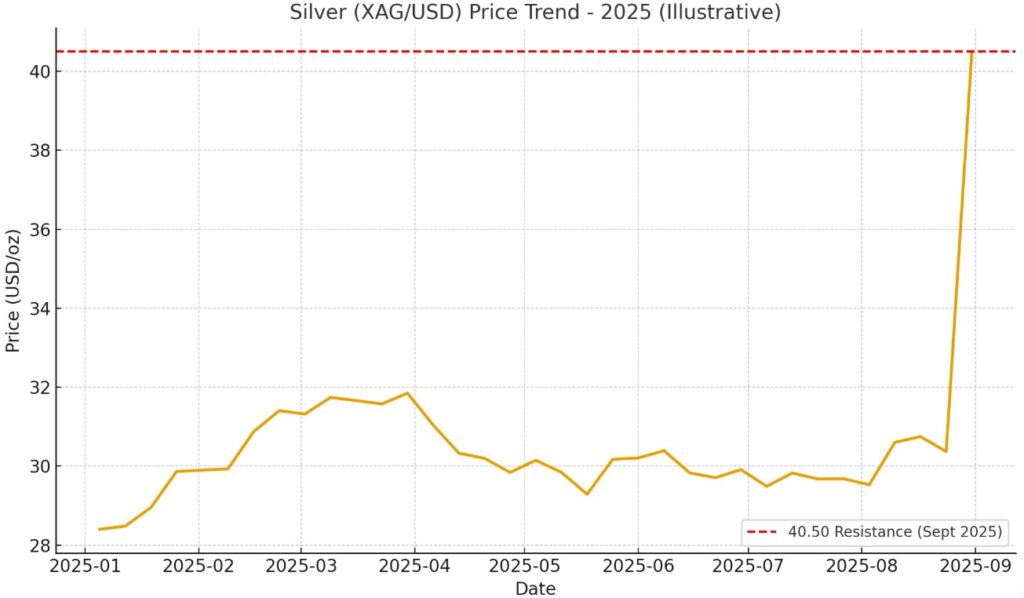
Silver Market Outlook in 2025
Macro backdrop
- Federal Reserve easing cycle: Markets are pricing a U.S. rate cut in September. Lower yields reduce the opportunity cost of holding metals, boosting silver’s appeal.
- Dollar dynamics: A softer dollar has added to momentum. Any reversal could weigh on prices.
- Safe-haven flows: Political uncertainty and uneven global growth have fueled demand for tangible stores of value.
Industrial demand
- Silver is unique among precious metals: it’s both a monetary hedge and an industrial metal. According to the World Silver Survey 2024, industrial demand hit 680.5 million ounces, the highest on record, driven by Solar panels (photovoltaics), Electric vehicles, Advanced electronics.
Safe Asset
- Silver continues to benefit from its reputation as a safe-haven asset. Geopolitical uncertainty and uneven global growth have encouraged diversification into hard assets. These three drivers explain why silver has returned to levels not seen since its 2011 peak.
Is Silver Expected to Go Up or Down?
The outlook for silver remains divided. Bulls argue that with U.S. monetary easing ahead, inflation still elevated, and industrial usage rising, silver has room to extend its rally. Technical traders are also watching the $43.40 level, which was last touched in September 2011, as a key resistance point. A break above this could confirm further upside momentum.
On the other hand, there are risks. A rebound in the U.S. dollar or Treasury yields could cap gains and push silver back toward the mid-$30 range. If global economic activity slows, industrial demand could weaken, reducing the fundamental support for prices. For now, silver is holding a bullish bias, but traders should remain alert to changing macroeconomic conditions.
Will Silver Go Over $100 an Ounce?
The possibility of silver reaching $100 per ounce is often raised in bull markets, but the reality is more cautious. Most bank forecasts for 2025 and 2026 remain far below that level, typically clustering between $30 and $50. Independent bullish analysts suggest that under extraordinary conditions such as aggressive central bank easing, supply shortages, and surging demand from renewable energy, silver might push toward $70–$80 by 2030.
A $100 price remains a tail scenario, not a base case. Traders should treat it as a possibility under extreme market shifts rather than an expectation.
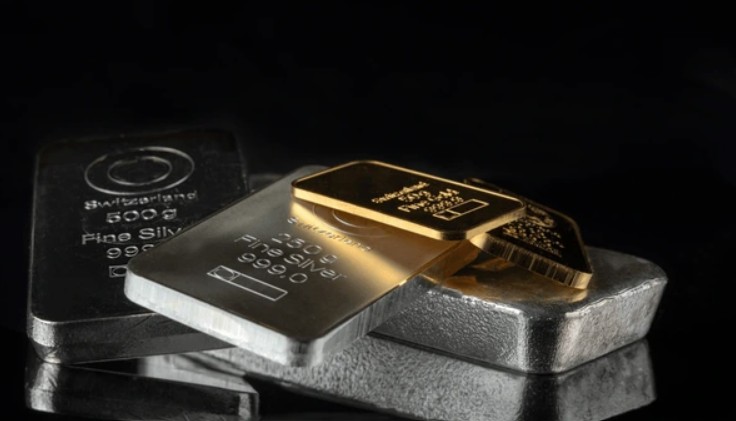
Silver Price Forecast for the Next 5 Years
Looking out to 2030, silver’s performance will depend on three key variables. The first is monetary policy. If central banks keep rates lower for longer, silver could remain well-supported. The second is industrial demand, particularly from the green transition. Solar power installations and EV adoption continue to expand, and both rely heavily on silver. The third factor is supply. Mining output has grown only modestly, and declining ore grades may limit future supply growth.
Forecasts vary, but a reasonable base case suggests silver will trade between $30 and $50 per ounce over the next five years. A bullish scenario, driven by structural demand and constrained supply, could push prices above $60. A bearish outcome, triggered by global slowdown and stronger risk appetite, might bring prices back toward $20–$25.
Is XAG a Good Investment?
Yes, silver (XAG/USD) can be a good investment when used as a portfolio diversifier and inflation hedge. It combines safe-haven appeal with strong industrial demand from solar, EVs, and electronics. However, silver is highly volatile, so traders should manage risk carefully and investors should avoid overexposure.
Whether silver is a good investment depends on the trader’s or investor’s goals. For active traders, silver’s volatility offers short-term opportunities around economic releases, central bank meetings, and dollar movements. The key is disciplined risk management, as silver can swing sharply in both directions.
For long-term investors, silver can play the role of a portfolio diversifier and an inflation hedge. However, it should not be the sole asset in a portfolio. A measured allocation, balanced with equities, bonds, and other commodities, ensures that investors capture the benefits of silver without being overly exposed to its volatility.
Conclusion
Silver’s surge to multi-year highs highlights both its opportunities and risks. While the long-term outlook benefits from strong industrial demand and the green transition, volatility remains a constant challenge. For traders and investors, silver (XAG/USD) is best approached as part of a balanced strategy with disciplined risk management.
At Ultima Markets, we provide the tools, education, and secure trading environment you need to navigate these dynamic markets. Whether you are trading silver, forex, or other CFDs, our goal is to help you make informed decisions with confidence.
Disclaimer: This content is provided for informational purposes only and does not constitute, and should not be construed as, financial, investment, or other professional advice. No statement or opinion contained here in should be considered a recommendation by Ultima Markets or the author regarding any specific investment product, strategy, or transaction. Readers are advised not to rely solely on this material when making investment decisions and should seek independent advice where appropriate.



